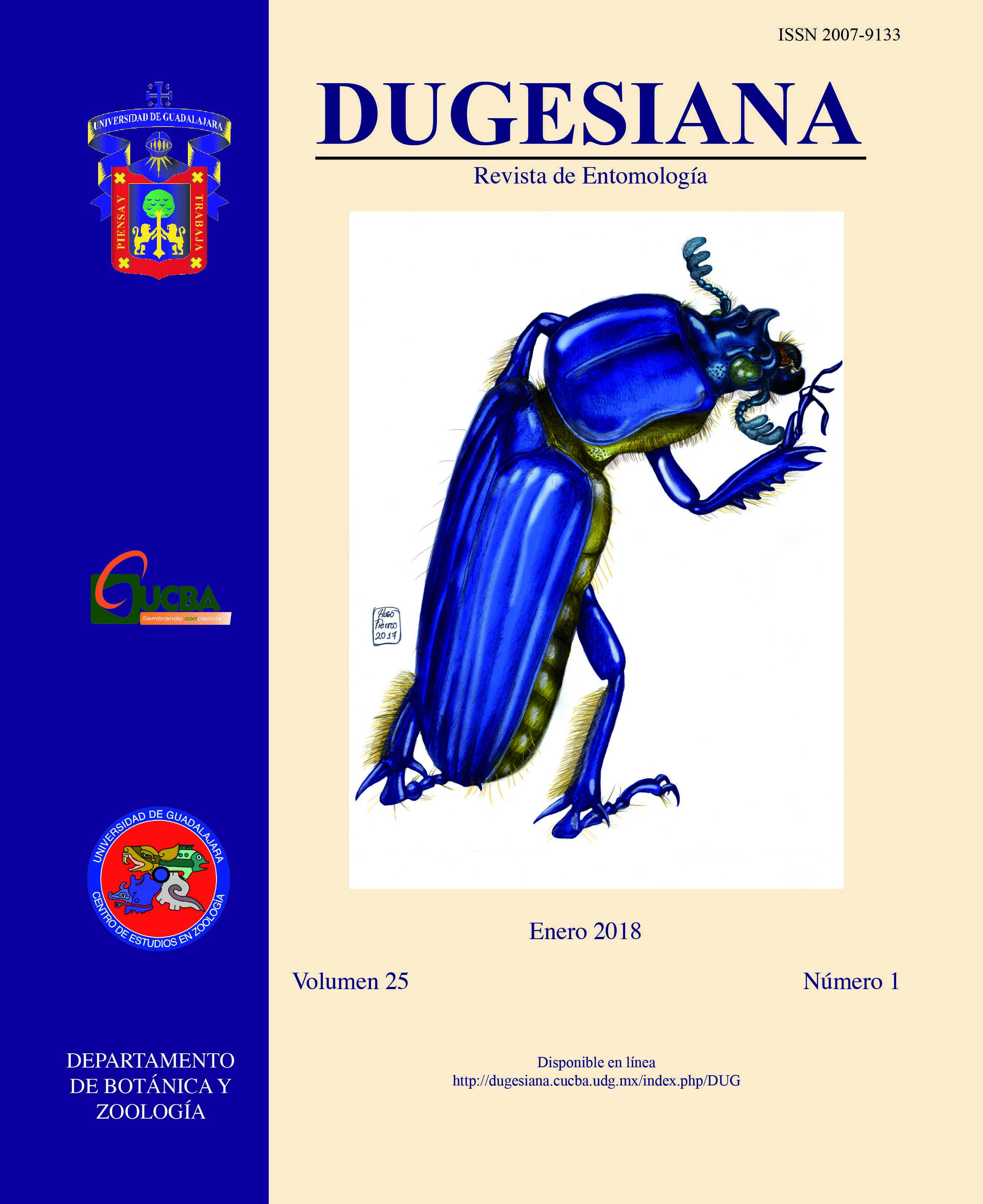Revisión del grupo de especies “pruinosa” de <em>Phyllophaga (Phytalus)</em> (Coleoptera: Melolonthidae: Melolonthinae)
DOI:
https://doi.org/10.32870/dugesiana.v25i1.6999Palavras-chave:
Melolontinos, taxonomía, nuevos registros, México, Centroamérica.Resumo
Se actualiza el grupo “pruinosa” formado por seis especies mexicanas y centroamericanas: P. pruinosa (Blanchard 1851) de Campeche, Chiapas, Hidalgo, Puebla, Oaxaca, San Luis Potosí, Tamaulipas y Veracruz, México; Rio San Juan, Nicaragua; Alajuela, Guanacaste, Heredia, Limón y San José, Costa Rica; P. tegulicolis Saylor 1934 de Chiapas, México; Santa Rosa, Guatemala; Morazán y Tegucigalpa, Honduras; P. tegenera Saylor 1935 de Carazo, Chinandega, Granada, Jinotega, Masaya y Rivas, Nicaragua; Guanacaste y Puntarenas, Costa Rica; P. hoogstraali Saylor 1943 de Guerrero, Michoacán, Morelos y Puebla, México; P. tlilloa n. sp. de Colima, Guerrero, Jalisco, estado de México, Morelos, Nayarit, Puebla y Sinaloa, México; y P. yautepecana n. sp. de Oaxaca, México. Se incluyen la diagnosis del grupo, las redescripciones de cuatro especies y las descripciones de dos especies nuevas, con ilustraciones de las estructuras diagnósticas, así como una clave para separar las especies del grupo.Referências
Blackwelder, R. E. 1944. Checklist of the coleopterous insects of Mexico, Central America, the West Indies, and South America. Part 2. Bulletin United States National Museum 185: 189-341.
Böving, A. G. 1942. A classification of larvae and adults of the genus Phyllophaga (Coleoptera: Scarabaeidae). Memoirs of the Entomological Society of Washington 2: 1-96.
Dalla-Torre, K. W. 1912. Scarabaeidae: Melolonthinae III Pars 49. Vol. 20. (pp. 135-290). In: S. Schenkling (ed.). Coleopterorum Catalogus. W. Junk, Berlin.
Evans, A. V. 2003. A checklist of the New World chafers (Coleoptera: Scarabaeidae, Melolonthinae). Zootaxa 211: 1-458.
Frey, G. 1975. Bestimmungstabelle der südamerikanischen Arten der Gattung Phyllophaga Harris und ihrer Untergattung Phytalus Er. (Col. Melolonthidae). Entomologische Arbeiten Museum Frey 26: 201-226.
Morón, M. A. 1986. El género Phyllophaga en México. Morfología, distribución y sistemática supraespecífica. Instituto de Ecología, México.
Morón, M. A. 1996. Coleópteros Melolonthidae asociados con las flores de Hibiscus rosa-sinensis L. (Malvaceae) en la región de Xalapa, Veracruz, México. Giornale italiano di Entomologia 8(2): 111-123.
Morón, M. A. 2003. Revision of the Phyllophaga s.s. schizorhina species group (Coleoptera: Melolonthidae; Melolonthinae). The Canadian Entomologist 135 (2): 213-302.
Morón, M. A. 2006. Revisión de las especies de Phyllophaga (Phytalus) grupos obsoleta y pallida (Coleoptera: Melolonthidae: Melolonthinae). Folia Entomológica Mexicana 45 (Supl.1): 1-104.
Morón, M. A. 2013. Revisión del nuevo grupo de especies orosina de Phyllophaga (s. str.) (Coleoptera: Melolonthidae). Elytron 26: 49-76.
Morón, M. A. 2017. Sinopsis del nuevo grupo de especies “puberea” de Phyllophaga (Phytalus) (Coleoptera: Melolonthidae: Melolonthinae). Elytron 29: 3-33.
Rivera-Gasperín, S. L. y M. A. Morón. 2013. Análisis filogenético del subgénero Phyllophaga (Triodonyx) (Coleoptera: Melolonthidae: Melolonthinae). Revista Mexicana Biodiversidad 84: 802-817.
Rivera-Gasperín, S. L. y M. A. Morón. 2017a. Phylogenetic relationships within Phyllophaga Harris (sensu lato) (Coleoptera: Melolonthidae, Melolonthinae) with emphasis on Listrochelus Blanchard. Neotropical Entomology DOI: 10.1007/s13744-017-0482-6
Rivera-Gasperín, S. L. y M. A. Morón. 2017b. Relaciones filogenéticas de las especies de Chlaenobia con otros miembros de Phyllophaga (s. lato) (Coleoptera: Melolonthidae: Melolonthinae). Revista Mexicana de Biodiversidad 88:
Sanderson, M. L. 1958. Faunal affinities of Arizona Phyllophaga, with notes and descriptions of new species. Journal of the Kansas Entomological Society 31(2): 158-173.
Saylor, L. W. 1942. Notes on beetles related to Phyllophaga Harris with descriptions of new genera and subgenera. Proceedings United States National Museum 92 (3145): 157-165.
Simeón, R. 1977. Diccionario de la lengua Náhuatl o Mexicana. Siglo XXI, México.
Wheeler, Q. D. and N. I. Platnick. 2000. The phylogenetic species concept (sensu Wheeler and Platnik). (pp. 55-69) In: Wheeler, Q. D. and R. Meier (eds.). Species concepts and phylogenetic theory: a debate. Columbia University Press, New York.
Downloads
Publicado
Edição
Seção
Licença
1. Política propuesta para revistas que ofrecen acceso abierto
Aquellos autores/as que tengan publicaciones con esta revista, aceptan los términos siguientes:- Los autores/as conservarán sus derechos de autor y garantizarán a la revista el derecho de primera publicación de su obra, el cuál estará simultáneamente sujeto a la Licencia de reconocimiento de Creative Commons que permite a terceros compartir la obra siempre que se indique su autor y su primera publicación esta revista.
- Los autores/as podrán adoptar otros acuerdos de licencia no exclusiva de distribución de la versión de la obra publicada (p. ej.: depositarla en un archivo telemático institucional o publicarla en un volumen monográfico) siempre que se indique la publicación inicial en esta revista.
- Se permite y recomienda a los autores/as difundir su obra a través de Internet (p. ej.: en archivos telemáticos institucionales o en su página web) antes y durante el proceso de envío, lo cual puede producir intercambios interesantes y aumentar las citas de la obra publicada. (Véase El efecto del acceso abierto).
2. Política propuesta para revistas que ofrecen acceso abierto diferido
Aquellos autores/as que tengan publicaciones con esta revista, aceptan los términos siguientes:- Los autores/as conservarán sus derechos de autor y garantizarán a la revista el derecho de primera publicación de su obra [ESPECIFICAR PERIODO DE TIEMPO], el cuál estará simultáneamente sujeto a la Licencia de reconocimiento de Creative Commons que permite a terceros compartir la obra siempre que se indique su autor y su primera publicación esta revista.
- Los autores/as podrán adoptar otros acuerdos de licencia no exclusiva de distribución de la versión de la obra publicada (p. ej.: depositarla en un archivo telemático institucional o publicarla en un volumen monográfico) siempre que se indique la publicación inicial en esta revista.
- Se permite y recomienda a los autores/as difundir su obra a través de Internet (p. ej.: en archivos telemáticos institucionales o en su página web) antes y durante el proceso de envío, lo cual puede producir intercambios interesantes y aumentar las citas de la obra publicada. (Véase El efecto del acceso abierto).




